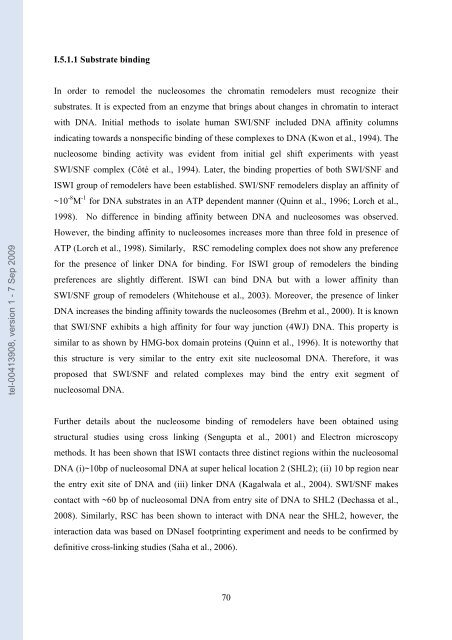Etudes sur le mécanisme de remodelage des nucléosomes par ...
Etudes sur le mécanisme de remodelage des nucléosomes par ...
Etudes sur le mécanisme de remodelage des nucléosomes par ...
Create successful ePaper yourself
Turn your PDF publications into a flip-book with our unique Google optimized e-Paper software.
tel-00413908, version 1 - 7 Sep 2009<br />
I.5.1.1 Substrate binding<br />
In or<strong>de</strong>r to remo<strong>de</strong>l the nuc<strong>le</strong>osomes the chromatin remo<strong>de</strong><strong>le</strong>rs must recognize their<br />
substrates. It is expected from an enzyme that brings about changes in chromatin to interact<br />
with DNA. Initial methods to isolate human SWI/SNF inclu<strong>de</strong>d DNA affinity columns<br />
indicating towards a nonspecific binding of these comp<strong>le</strong>xes to DNA (Kwon et al., 1994). The<br />
nuc<strong>le</strong>osome binding activity was evi<strong>de</strong>nt from initial gel shift experiments with yeast<br />
SWI/SNF comp<strong>le</strong>x (Côté et al., 1994). Later, the binding properties of both SWI/SNF and<br />
ISWI group of remo<strong>de</strong><strong>le</strong>rs have been established. SWI/SNF remo<strong>de</strong><strong>le</strong>rs display an affinity of<br />
~10 -8 M -1 for DNA substrates in an ATP <strong>de</strong>pen<strong>de</strong>nt manner (Quinn et al., 1996; Lorch et al.,<br />
1998). No difference in binding affinity between DNA and nuc<strong>le</strong>osomes was observed.<br />
However, the binding affinity to nuc<strong>le</strong>osomes increases more than three fold in presence of<br />
ATP (Lorch et al., 1998). Similarly, RSC remo<strong>de</strong>ling comp<strong>le</strong>x does not show any preference<br />
for the presence of linker DNA for binding. For ISWI group of remo<strong>de</strong><strong>le</strong>rs the binding<br />
preferences are slightly different. ISWI can bind DNA but with a lower affinity than<br />
SWI/SNF group of remo<strong>de</strong><strong>le</strong>rs (Whitehouse et al., 2003). Moreover, the presence of linker<br />
DNA increases the binding affinity towards the nuc<strong>le</strong>osomes (Brehm et al., 2000). It is known<br />
that SWI/SNF exhibits a high affinity for four way junction (4WJ) DNA. This property is<br />
similar to as shown by HMG-box domain proteins (Quinn et al., 1996). It is noteworthy that<br />
this structure is very similar to the entry exit site nuc<strong>le</strong>osomal DNA. Therefore, it was<br />
proposed that SWI/SNF and related comp<strong>le</strong>xes may bind the entry exit segment of<br />
nuc<strong>le</strong>osomal DNA.<br />
Further <strong>de</strong>tails about the nuc<strong>le</strong>osome binding of remo<strong>de</strong><strong>le</strong>rs have been obtained using<br />
structural studies using cross linking (Sengupta et al., 2001) and E<strong>le</strong>ctron microscopy<br />
methods. It has been shown that ISWI contacts three distinct regions within the nuc<strong>le</strong>osomal<br />
DNA (i)~10bp of nuc<strong>le</strong>osomal DNA at super helical location 2 (SHL2); (ii) 10 bp region near<br />
the entry exit site of DNA and (iii) linker DNA (Kagalwala et al., 2004). SWI/SNF makes<br />
contact with ~60 bp of nuc<strong>le</strong>osomal DNA from entry site of DNA to SHL2 (Dechassa et al.,<br />
2008). Similarly, RSC has been shown to interact with DNA near the SHL2, however, the<br />
interaction data was based on DNaseI footprinting experiment and needs to be confirmed by<br />
<strong>de</strong>finitive cross-linking studies (Saha et al., 2006).<br />
70

















